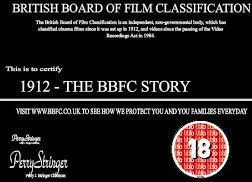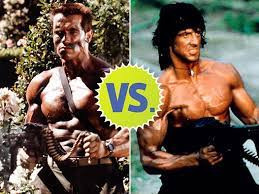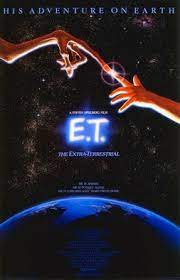This is the second part of the William Friedkin section and focuses on the more heavyweight considerations of censorship relating to violence and the treatment of the Holocaust in feature films. Ironically, it also deals with whether films could be viable educational tools for learning history. At the time of writing the thesis, I had no desire whatsoever to be a teacher but, several years later, when I did become a history teacher, I used feature films wherever possible.  Steven Spielberg is discussed here too; he is the only director in the thesis who has two films considered. The title Aliens vs. Dinosaurs comes from the discussion of the subject matter of two of his greatest hits that do not involve the Second World War. Little did I know at the time how Spielberg’s films and series would dominate this arena to this day and also lead to a resurgence in Second World War productions on both the big screen and the small.
Steven Spielberg is discussed here too; he is the only director in the thesis who has two films considered. The title Aliens vs. Dinosaurs comes from the discussion of the subject matter of two of his greatest hits that do not involve the Second World War. Little did I know at the time how Spielberg’s films and series would dominate this arena to this day and also lead to a resurgence in Second World War productions on both the big screen and the small.
Censorship
Most censorship of film was by governmental bodies such as the Hays Commission in the United States, which was: “a self-regulatory body, [which]had a list of eleven [expletive] ‘don’ts’ and twenty-five ‘be-carefuls’. These guidelines were also known as the Motion Picture Production Code and lasted until the 1960s.”  In Britain, the British Board of Film Classification (BBFC) established in 1913 acts as a censor, the board’s decision is final and there is no means of appeal. In this study, this board has the most tremendous significance because all films viewed have been the British-released versions while all, but Saving Private Ryan were viewed on video.
In Britain, the British Board of Film Classification (BBFC) established in 1913 acts as a censor, the board’s decision is final and there is no means of appeal. In this study, this board has the most tremendous significance because all films viewed have been the British-released versions while all, but Saving Private Ryan were viewed on video.
Violence
“Since the early 1900s, violence has been the most controversial and emotive aspect of the movies.” The earlier period of films considered here made between 1939 and 1969 was potentially seen by audiences that had experienced the horrors of the war first-hand, therefore, it was possibly deemed tasteless for filmmakers to highlight such scenes.
The prevalent sentiments in films of this period were those of good feeling and pride of achievement in having beaten the Germans, which continued the theme of pro-war propaganda films synonymous with the war years.
The move away from such sentiments was due to several factors that arose in the 1960s and 1970s such as the emergence of television. Television, with its ability to bring almost real-time reportage into peoples’ living rooms, meant that the real horrors of the Vietnam War were widely viewed.
Censorship of such material was less than in the Second World War and reports from battles were common. John Trevelyan, who was secretary of the BBFC between 1958 and 1971 having joined the board in 1951, said:
“If there was enough of it [screen violence, then it will] desensitize people so that they find violence both normal and acceptable.” The increase of explicit violence, much of it gratuitous, rapidly transferred from reportage of the Vietnam War to fantasy on the big screen.  This trend began in the early 1960s and continued through the 1970s and the 1980s with films starring heroes such as Sylvester Stallone and Arnold Schwarzenegger with ever-increasing body counts. In conjunction with better technology allowing more realistic film effects, war filmmakers have subsequently re-enacted most life-like situations, such as explosions and injuries. The advancement is most noticeable in Steven Spielberg’s Saving Private Ryan in 1988.
This trend began in the early 1960s and continued through the 1970s and the 1980s with films starring heroes such as Sylvester Stallone and Arnold Schwarzenegger with ever-increasing body counts. In conjunction with better technology allowing more realistic film effects, war filmmakers have subsequently re-enacted most life-like situations, such as explosions and injuries. The advancement is most noticeable in Steven Spielberg’s Saving Private Ryan in 1988.
The Holocaust
The Holocaust arguably presents filmmakers with the most difficulty. The horrific events were eventually [there had been others but not portrayed in this way] portrayed by a major Hollywood film in Steven Spielberg’s Schindler’s List in 1993.  Despite its horrific subject matter, it achieved both commercial success and critical acclaim. The use of stark black and white film portrayed events in the film with even more emotion.
Despite its horrific subject matter, it achieved both commercial success and critical acclaim. The use of stark black and white film portrayed events in the film with even more emotion.
Educational Tool
Schindler’s List also requires comments on whether there is any value in war films being used as an educational tool and whether filmmakers have sought to utilize their films in this role. The problems in using film in this way are many. Films are dramatized depictions of true or completely fabricated stories with facts excluded or exaggerated to create a more exciting story.
This point is highlighted during the opening credits of the Great Escape in 1963: “This is a true story/ Although the characters are composites of real men, and time and place have been compressed, every detail of the escape is as it really happened.” Here the filmmaker admits a true story has been adapted to suit the demands of a feature film. Stereotypical German attributes were undoubtedly utilized in propaganda films of the war and immediately post-war years.
Any discussion of historical facts in relation to the educational value of war films returns to earlier discussions of realism. Realistic portrayals of, for example, action sequences, in conjunction with the use of computers, bridge the gap between documentary newsreels and feature films to a greater extent than ever before.
Special effects can create more realistic wounds, explosions, and bullet strikes, such as in Saving Private Ryan. However, though war films have become more realistic in some ways, it must be remembered by both the viewer and the filmmaker that the world of feature films is one of fantasy.
Feature films are influential in developing peoples’ beliefs, but the filmmaker has limited influence over what the viewer deems as fantasy or reality. Therefore, the viability of utilizing feature films as an educational tool is filled with difficulties.
The tensions between educational and fantasy films are further highlighted by the fact that Steven Spielberg, who directed Schindler’s List and Saving Private Ryan also directed ET: The Extra-Terrestrial, the most successful children’s fantasy film of all time [at the time of writing] as well as Jurassic Park and Jaws.  Therefore, this study will consider the educational aspects, if any, of the films included.
Therefore, this study will consider the educational aspects, if any, of the films included.
The first film considered in the thesis is (As an Amazon Associate I earn from qualifying purchases) Foreign Correspondent
What’s Next?
Next on the agenda is completing the Oppenheimer review and the subsequent review of the visit to Rhydymwyn. My sister has also pointed me in the direction of the novel, The Diamond Eye by Kate Quinn, the story of a female Russian sniper. I look forward to it and any other recommendations and comments.
Keep reading and take care
BigT

The content you have in your website that is named Second World War Books, is not truly relevant to the title. You have Films here that you are talking about, with a brief mention of the book.
Secondly, you have mention of E.T. Jaws, as well as Jurassic Park, which have nothing to do with World War of any kind.
I suggest you focus on the books associated with the Author you chose and mention briefly about films that may be associated with the actual books.
The layout of your site is very well organized. Looks nice with photos.
Your writing is great.
Nice work, just reverse content to relate to your title.
Firstly, thank you for taking the time to look at my website a read some of its content. Secondly, Thank you for your fair criticism of this particular blog. I agree that the website name is somewhat misleading when this blog is discussing films. When I originally set up the site, the idea was to post nothing but book reviews. However, I soon realised that my interest in writing about the war is inspired by more than just books. In addition, I believe that many people first come across aspects of the war through other media apart from books and particularly through films or TV series. Some of these then find the books once their interest has been tweaked.
One of the intents of this website is to promote discussion of the war and further people’s knowledge of it. As I have been developing the website, I realised that discussing just books would limit this, hence a discussion of other media. This particular blog is part of a thesis I wrote about Second World War films many years ago.
There a several blogs in the pipeline discussing books, so I hope you will return in the future and read those. Thank you again for visiting my site and taking the time to ‘put pen to paper’ yourself.
All the best BigT